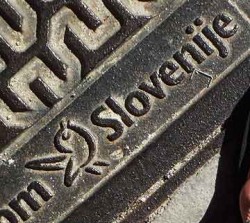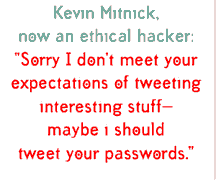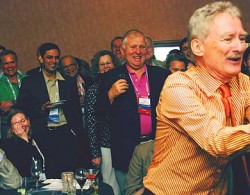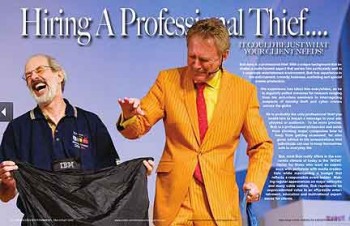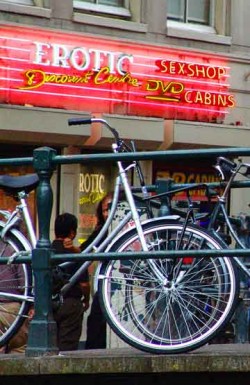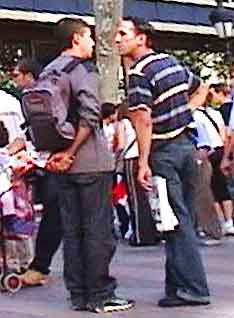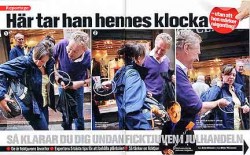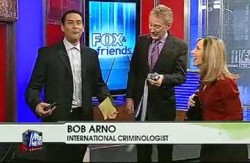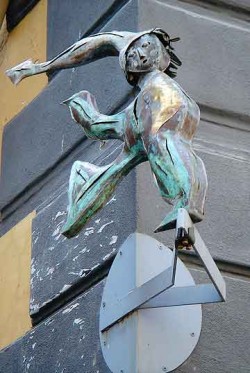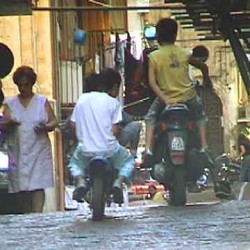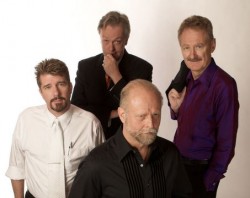
The Slovene driver sped along the autostrade, disco crackling on the radio, fast-chomping gum, taking and making phone calls as if he runs another business. Beautiful coastline, like Italy next door. Construction in progress everywhere. Violet lupine and red-orange poppies brilliant along grassy roadsides.
The driver dropped us at Grand Hotel St. Bernardin in Portoroz. Our suite overlooked the Adriatic from three balconies. I could almost see Venice—or where Venice should have been across the sea.
We were in Slovenia to perform and lecture at Microsoft’s industry conference introducing windows 7. Instead of the usual rushed “play-and-run” routine, we scheduled four days in Slovenia in order to do extra events there, for Microsoft and for ourselves.
As Mac users, we felt like peacocks in a flock of pigeons, but we were quickly proved wrong by many furtive glances of attendees and IT staffers as they peeked at iPhones partly pulled from their pockets.
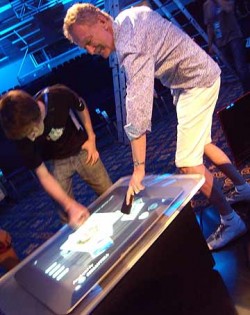
First was rehearsal for Bob’s keynote session, open to the conference’s 2,000 attendees. Here was a highlight of the trip for me: an uninterrupted opportunity to play with a Surface Table, aka Big-Ass Table, which sat on stage. Its smooth multi-touch interface allowed me to use both hands to draw and manipulate objects, while Bob and a couple of stage hands simultaneously played on the table.
I’ve been fascinated by the multi-touch user interface ever since I saw Jeff Han’s TED talk —the first TED talk I’d ever seen. (Now I try to watch one or two every night—at least once in a while. I go on binges.) It’s the same technology as CNN’s “Magic Wall,” and FoxNews’ “Bill Board;” like a giant Apple iPhone. Fun to play with.
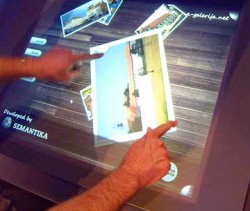
The youngest IT staffer I spoke with, 19 years old, confided in me after chatting and playing on the table together.
“I’ve got such a headache,” he baited me.
“Why?”
“I had to load windows 7 on 32 netbooks this morning. Fifteen of them wouldn’t work. I had to take them all apart and replace cables and stuff, then put them back together and reinstall 7.”
Poor boy.
The keynote, scheduled to last two hours, ran an entire hour over. Bob (eventually) shared the stage with Slovene actor and comedian Džuro (somebody help me with his last name). Little video here.
When the whole hotel internet went down during the Microsoft conference, everyone wondered: server overload? hackers? Where’s the IT guy? Booths, demos, work, everything ground to a halt. Embarrassment all around.
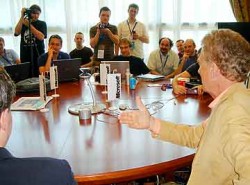
A long interview with the national paper, Dnevnik, resulted in a two-and-a-half page spread we’ve been told reads well. A google translation of the Slovenian turns up some hilarious lines: Reporter: “You can dance monkey dance? Bob: “Whatever Let it be loud and crazy.” Reporter: “Men in adjacent table…has bag at feet. You can steal now?” Bob: “Can.” [and he did] “in 15 seconds… embarrassment evident by redness of face.”
And Bob supposedly said “People like the sheep shearer,” and later: “Ah, no. Not like this, as we are now. You should fuck in you or something.”
Remember the children’s game of telephone, or operator? Well, call this translation. From Bob’s Swedish to his English, from the reporter’s English to his Slovenian, and finally through Google’s processor.
Microsoft had arranged for Bob to appear at a press conference with its chief security analyst, Ed Gibson. When asked about some of windows 7’s new security features, Gibson quipped: “I’d demonstrate for you, but we don’t have two hours for windows to boot up.” I wouldn’t repeat that had Mr. Gibson not said it to 30 journalists. Short videos here and better, here.

Duties done, we drove to the Italian city of Trieste, just half an hour away, for sunset cocktails on the piazza. Campari aperitifs are de rigueur, as are cigarettes. (We stuck with just the cocktails.) We got a table before the joint became standing room only. Utterly pleasant, and time for passeggiata afterwards, in the right mood.
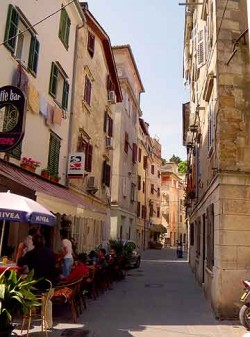
Despite my sarcasm, I want to emphasize that Slovenia is a lovely destination. The country’s terrain is beautiful, as are it’s coastline and views. We walked to Piran, the nearby town, which resembled Venice without the canals, crowds, or cruise ship passengers, and possibly lacking a fraction of the charm.
We found our hotel’s massive restaurant dismal and oppressive with overly formal appointments and stuffy service. Heavy curtains and high window sills obstructed a gorgeous view; and given the glorious weather, the windows should have been open. Fake plants are a turn-off.
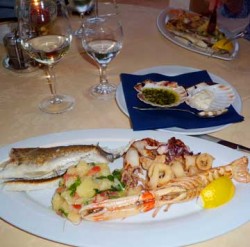
But nearby Barka restaurant, on the harbor, was perfect in every way: patio, menu, views, quality, good Slovenian wine, and a casual-but-correct wait staff. Once we discovered it, we returned for every meal.
Leaving out of Trieste airport, a huge 20-minute-storm cancelled our flight. Waiting in the airport restaurant until an evening flight, we watched three armed policia step up to the bar for drinks.
At the end of this trip, having visited Italy, Slovenia, and Paris, we returned home with no stamps in our new passports. Perhaps these will last longer than the previous ones did.
![]()

